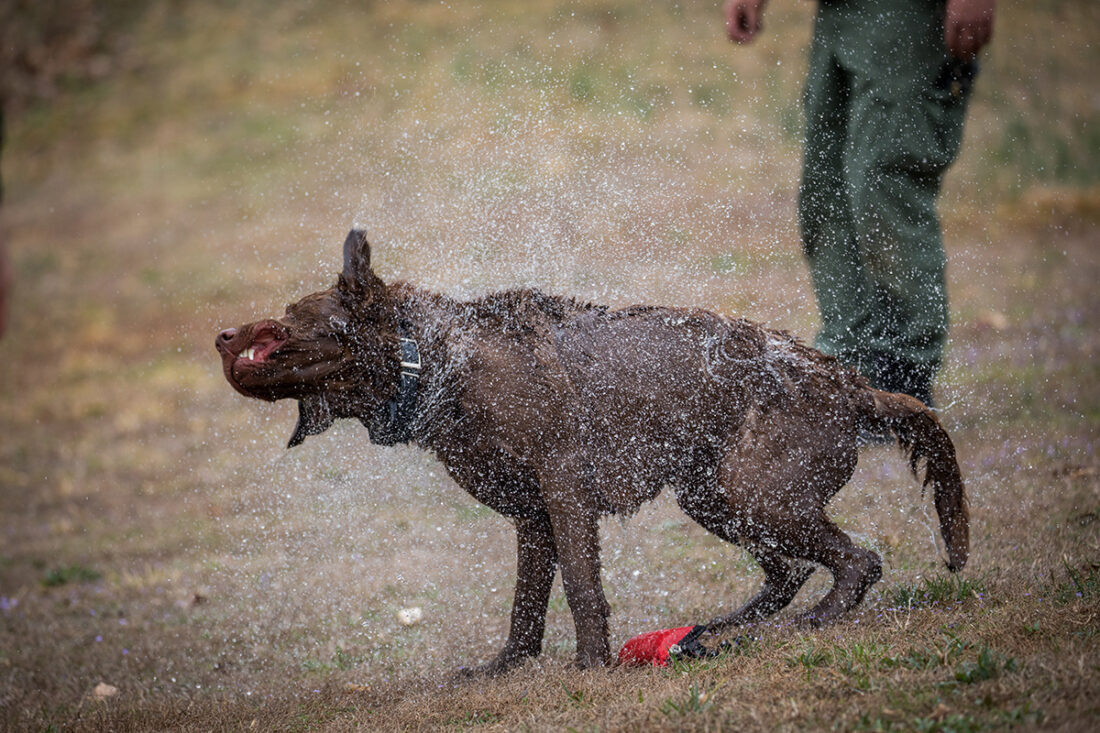
CPO Ian Ostlund rewards Reese after she successfully found a gun in the woods on an article search exercise.
By Molly Kirk
Photos by Meghan Marchetti
The five dogs in training to become K9 Conservation Police Officers with the Virginia Department of Wildlife Resources (DWR) continued their education with a session before restrictions due to the COVID-19 outbreak tightened. The dogs and their handlers moved on to work on searching for articles and detecting wildlife, in addition to continuing to hone their basic obedience and person-tracking skills. The different personalities of the dogs are becoming even more obvious, and the handlers are learning what approach to training works for their individual dog.
The DWR K9 program is supported by the Ward Burton Wildlife Foundation (WBWF). You can help by donating to the Caring for the CPO K9s Fund through WBWF. Your donation will go to veterinary care, maintenance costs, and training for the K9 CPOs.
Searching for items such as guns, shell casings, and articles of clothing is an essential skill for the K9 officers, as they can quickly and effectively locate evidence of a crime. They also learn to detect the presence of wild turkey and deer meat and fish in order to help enforce wildlife laws. While those two skills still use their acute sense of smell, they also differ from tracking a person in many ways. So, just as they have a harness that they wear while tracking, the also have specific collars that they wear while article searching and detecting wildlife.
Both collars go on with a distinctive click of a snap to signal the dog, while the handler uses a specific command, like “search” and “find it.” The dogs learn to identify what kind of search they’re expected to do by the collar and the command. When they find the article or wildlife, they’re trained to sit or lay down and stay still, alerting to the location, until the handler rewards them.
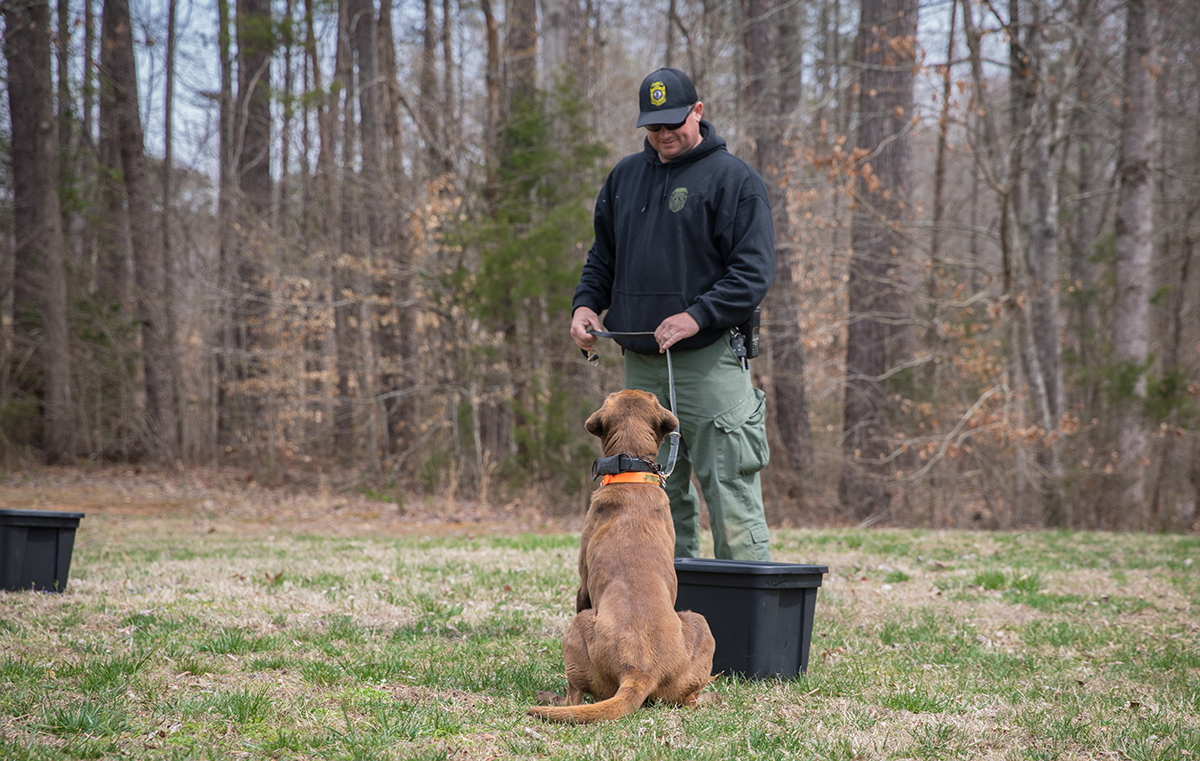
K9 Reese sits to alert her handler, CPO Ian Ostlund, that she’d detected wildlife meat in the container.
Master SPO Mark Diluigi noted that Lily, with her methodical approach, did well with learning article searches and wildlife detection. “She gets excited when she starts article searches,” he said. “We’re working on recall so she comes when she’s called, and that she changes direction when the command is given. I’m comfortable with what we’ve learned so far; she’s confident.”
Diluigi emphasized that the handlers are very aware of the need to keep training fun for the dogs. “They’re like kids doing math homework; if you pound the work into them for two hours, they’re not going to get it,” he said. “You have to keep track of how much time you’re working with them, so they don’t get bored or frustrated. You mix up the easy and hard things to keep them interested and confident.”
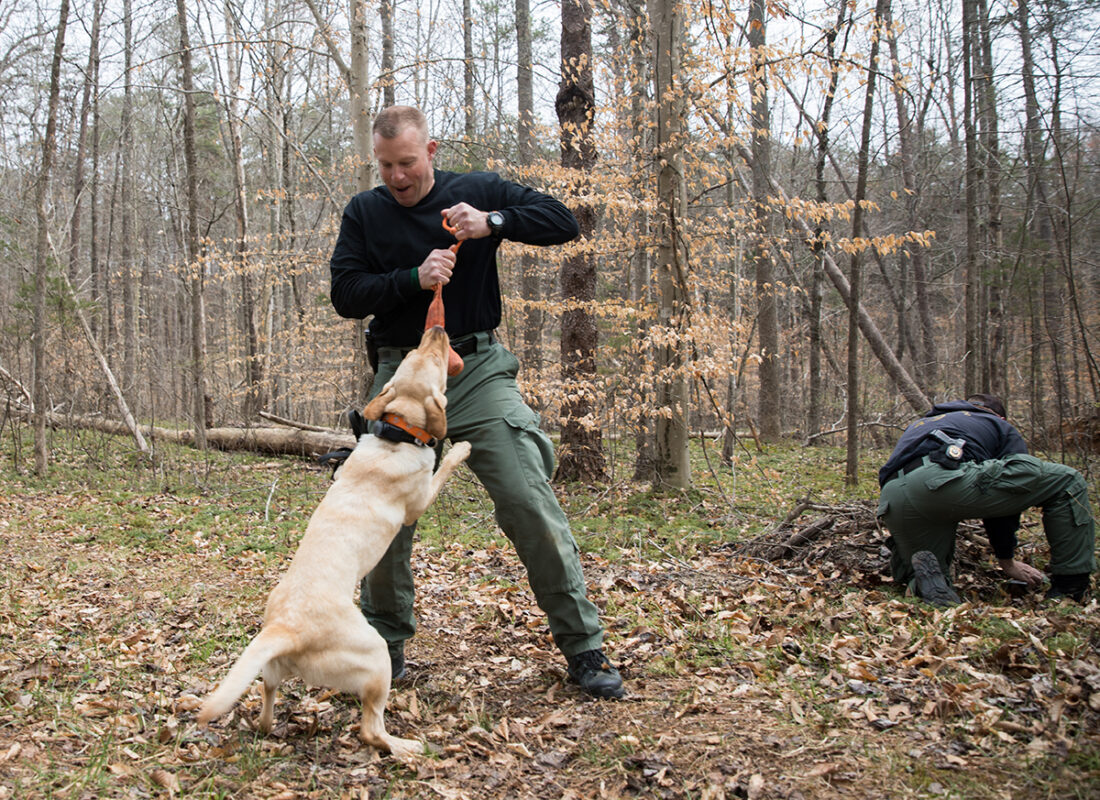
Master CPO Mark Diluigi rewards Lily with play after she successfully found a gun hidden in a pile of sticks and leaves.
Bruno is one of the younger dogs in the training, and CPO Tyler Blanks is pleased with his progression through the new skills. “Wildlife detection was entertaining for the first few days but he got the hang of it,” Blanks said. “We began by searching an indoor facility with no distractions. The scent items were hidden in concrete blocks and big plastic containers. Bruno would knock over the blocks like they were there for him to play with. I’d say he was the class clown for the first part of detection training, but pulled himself together during the last week. He did great searching vehicles and buildings with several distractions.
“I am proud of Bruno’s development in the training,” Blanks continued. “Some days are better than others but I am always able to see his progression. The training makes me excited to apply what we have learned to the field.”
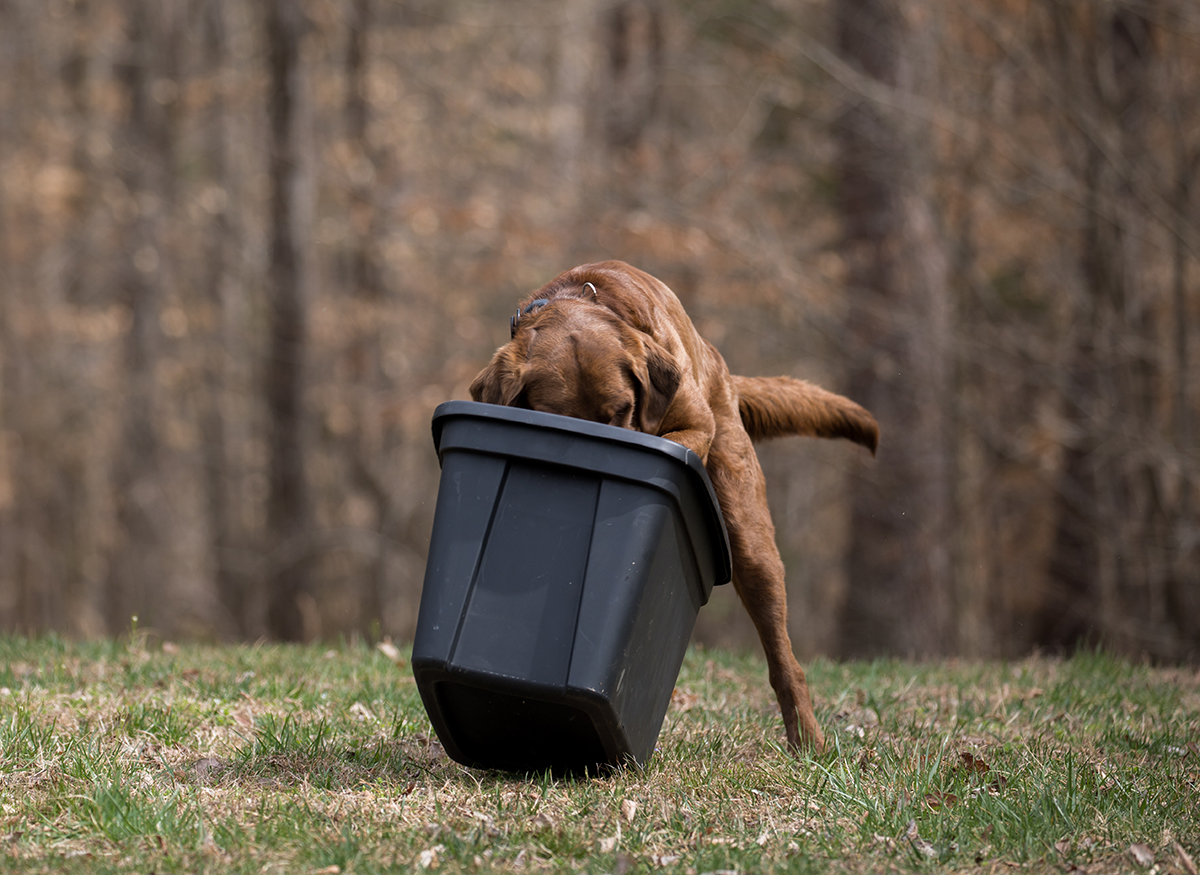
Bruno’s enthusiasm to get the job done shows as he detects wildlife meat in the container.
CPO Ian Ostlund had to work through a few challenges with Reese, his canine partner, as well. An big, powerful chocolate Lab, Reese is well-suited to tracking a person over longer distances or find an article in a large field or in the woods. “There’s a method to how she runs through the woods; I help to guide her in the area search, but she gets run free off-lead and work fast,” Ostlund said. “She loves it; it’s a big game for her. She gets really excited about finding an item.”
Working in the more controlled environment of wildlife detection indoors or in a vehicle was more difficult for Reese. She tended to want to bolt forward when Ostlund gave her a command, rather than work steadily. “One of the things I tried to do was speak to her in a lower, calmer voice,” he said. “I wanted her to be a little more mellow when she started that search, because you want the dog to be a bit more methodical in that search and make sure they hit all the areas. After a while, she definitely understood the game. I think she’s a very intelligent dog, but her drive is so high. That’s the one thing that I have to try to rein in at times.”
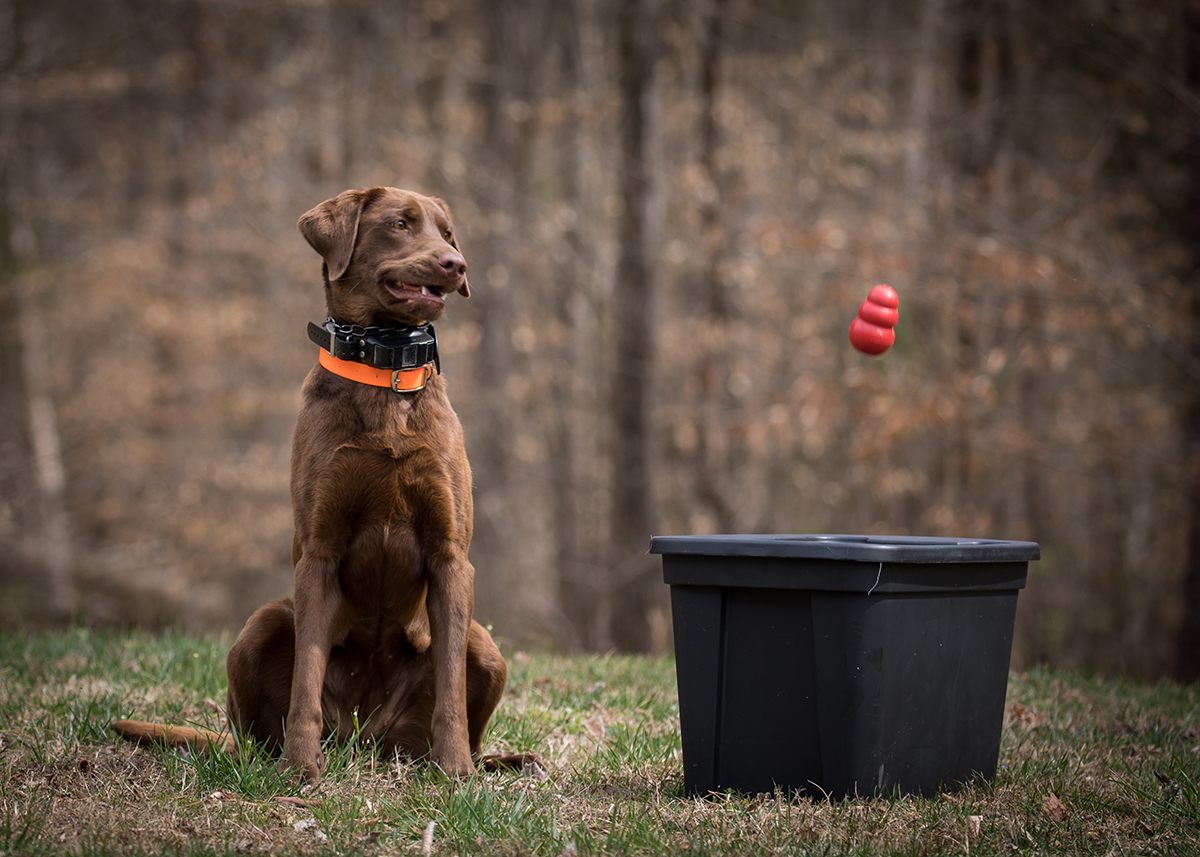
Reese has detected wildlife meat in the container and sat to alert her handler, so she’s rewarded with a Kong being thrown for her.
Molly is the second K9 that Senior CPO Wes Billings has trained for DWR, and he noticed that the chocolate Lab got a bit confused between the tracking work and article detection. “When we add the article search training, then ask them to do a mile track of a person, they can get a little confused until they learn how to do everything proficiently,” he said. “We’ll get it all straightened out. They have to process it all; when we give a command, they need to understand what we’re asking. A lot of it is based on what equipment we’re using. With a snap collar around their neck and the command to find articles, or when we put a harness on and ask them to track, they have to learn how to do the different tasks. Molly’s still doing really well, and we’ll keep explaining it to her.”
CPO Bonnie Braziel noticed that Grace’s boundless enthusiasm and high energy levels, which made her excel at person-tracking, hindered her a bit in the slower and more methodical tasks of article searching and wildlife detection. “She’d know exactly where the items were, but she knew she’d have to go back to the truck after she found them,” Braziel said.
“So she’d run around for a few minutes, then find them but not stay still and alert. She’d just run to it, put her nose to it, and keep going. I’ve had to step up the rewards for her and give her a high-value reward like chunks of hot dog to get her to really want to sit and stay with an article. There were times when she tested my patience, but she always tried hard. Probably about a week and a half in, she turned a corner and was sitting more readily when she found something,” Braziel continued.
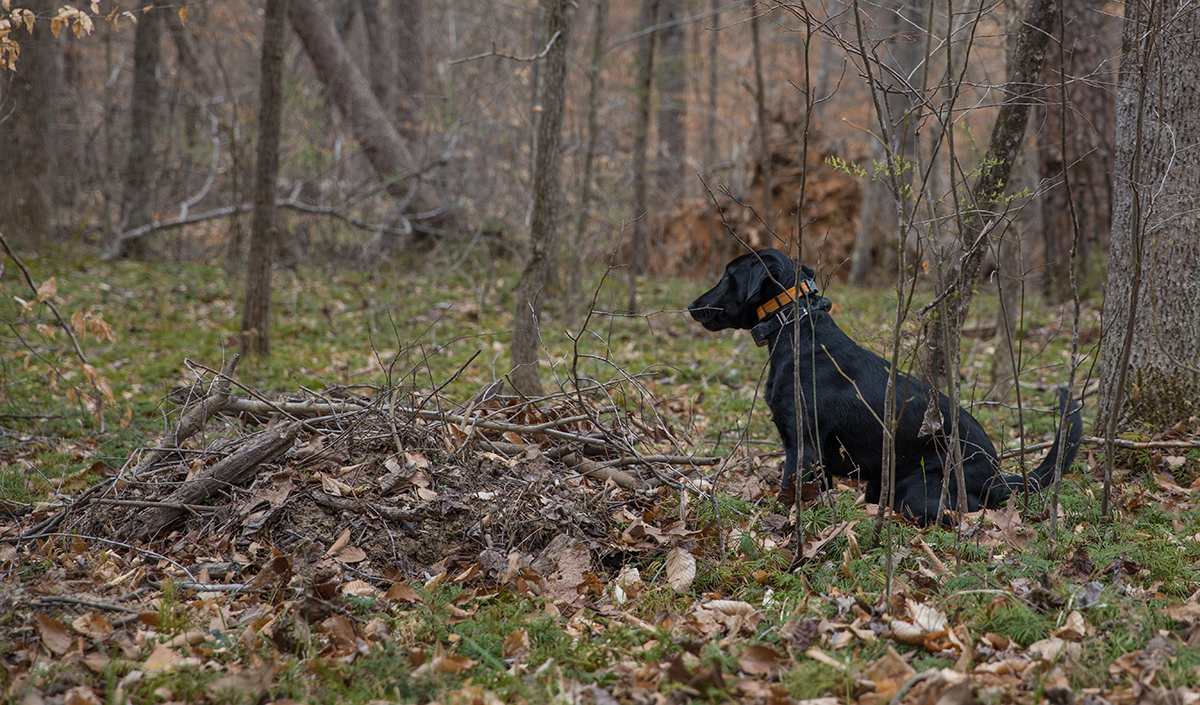
Grace sitting to alert that she’d found something.
At the end of the days of training, the handlers would frequently take the dogs to a pond for a swim, throwing toys into the water for them to retrieve. “At the end of the day, dogs still need to be dogs,” said Diluigi. “They need to play and swim. You can just see them relax when they do.”
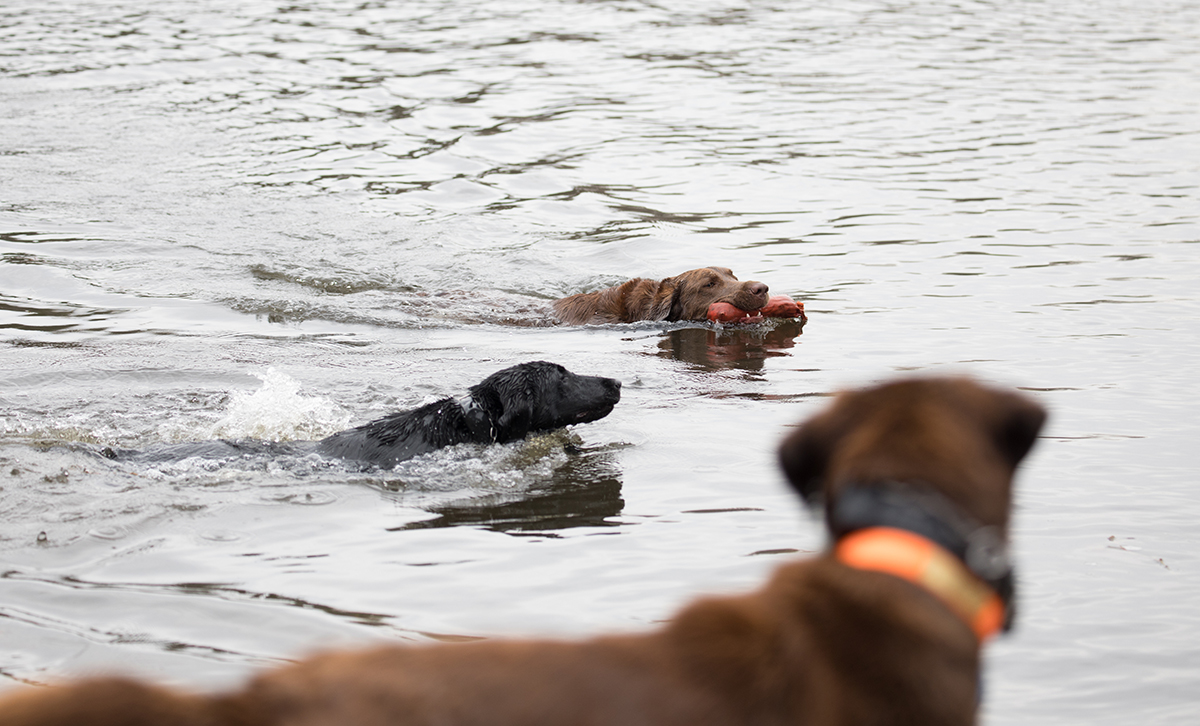
The dogs having some down time.
As they look forward to their last session of training and then graduation and certification as K9 Conservation Police Officers, the dogs and handlers continue to work on skills at home. The handlers practice basic obedience with the dogs and set up exercises for article searches and person-tracking in their back yards, sometimes recruiting family members to help.
“My fiancé has hidden pieces of turkey and guns and I’ve had her running from Grace,” Braziel said. “She’s even gotten into the lingo. She’ll tell me, ‘She head-snapped and got into the odor and worked her way back to it.’ She takes notes for me. It’s fun having my family see Grace work and do what she’s so good at.”
The K9s and handlers will complete a third session of training before their graduation and badge ceremony, which will take place at a date to be determined, depending on social distancing restrictions. Do you want to support the K9s as they continue to learn? Donate to the Caring for the CPO K9s Fund through the Ward Burton Wildlife Foundation to help them achieve their goals and to protect Virginia’s people and wildlife.
Donate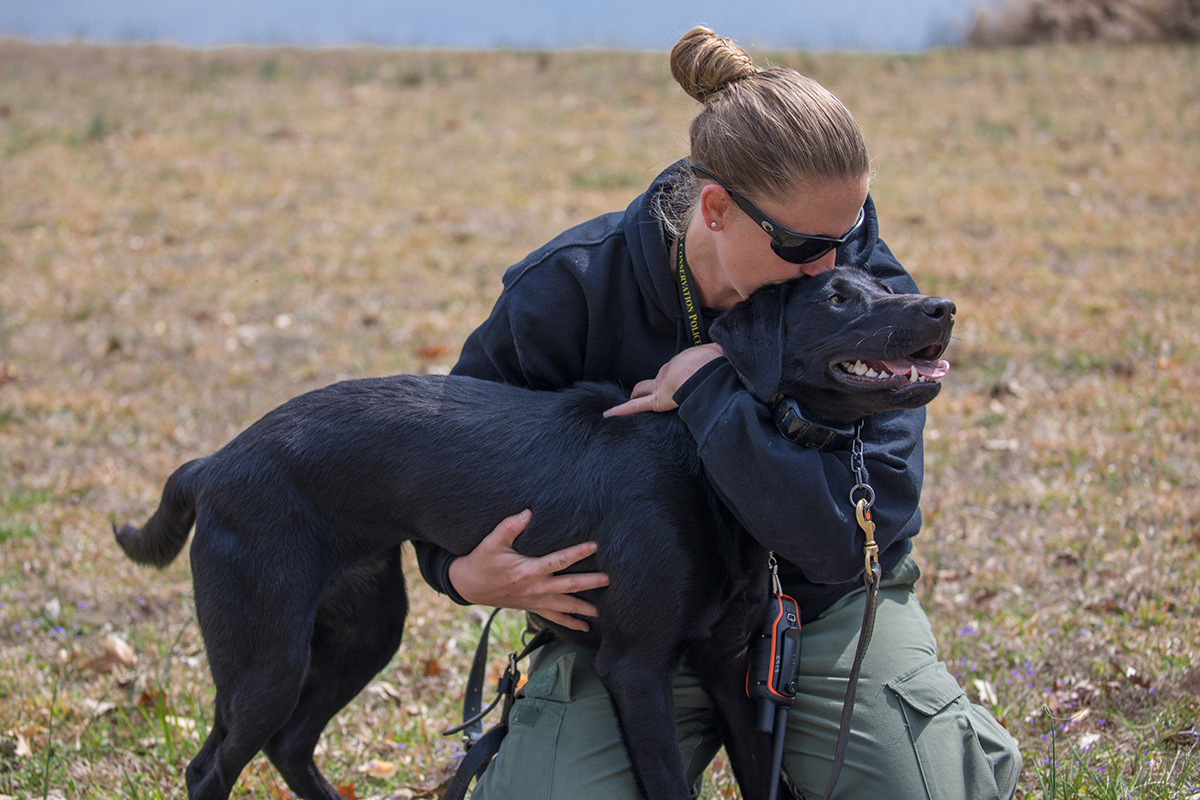
CPO Bonne Braziel and Grace bonding for a moment.

Bruno waiting for a command from CPO Tyler Blanks.
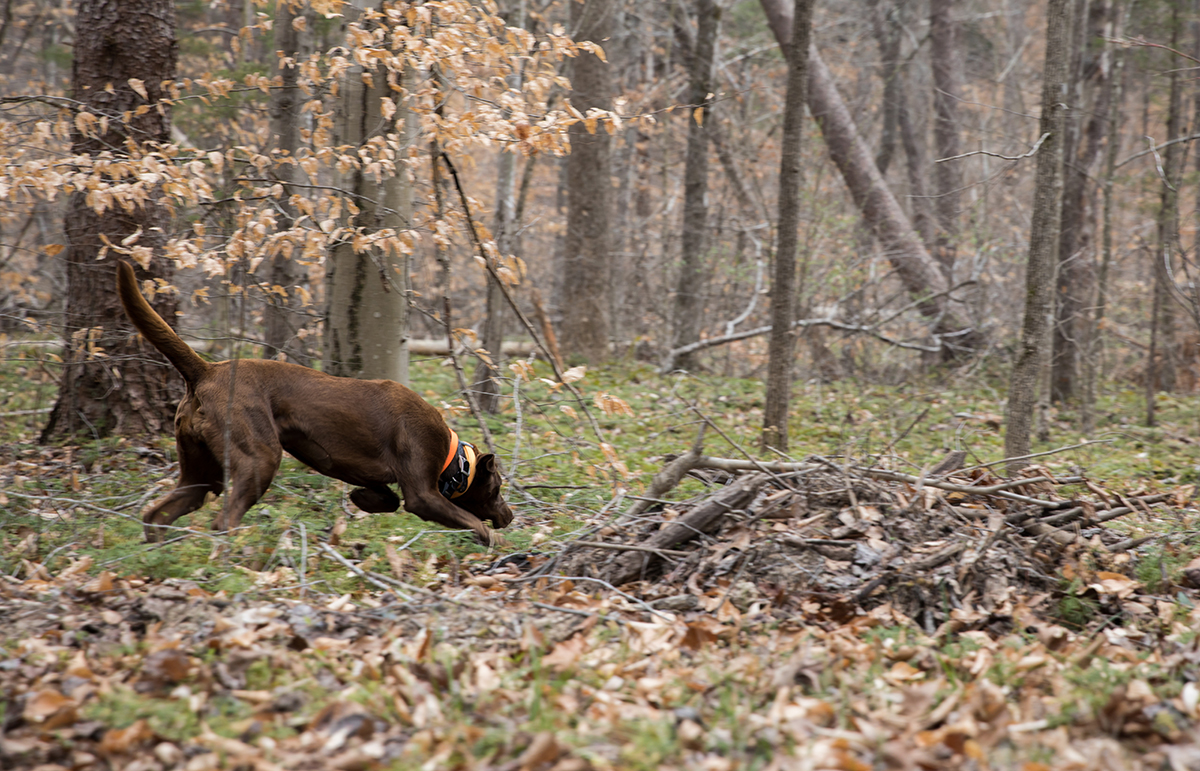
Reese finding a gun hidden in a pile of sticks and leaves.
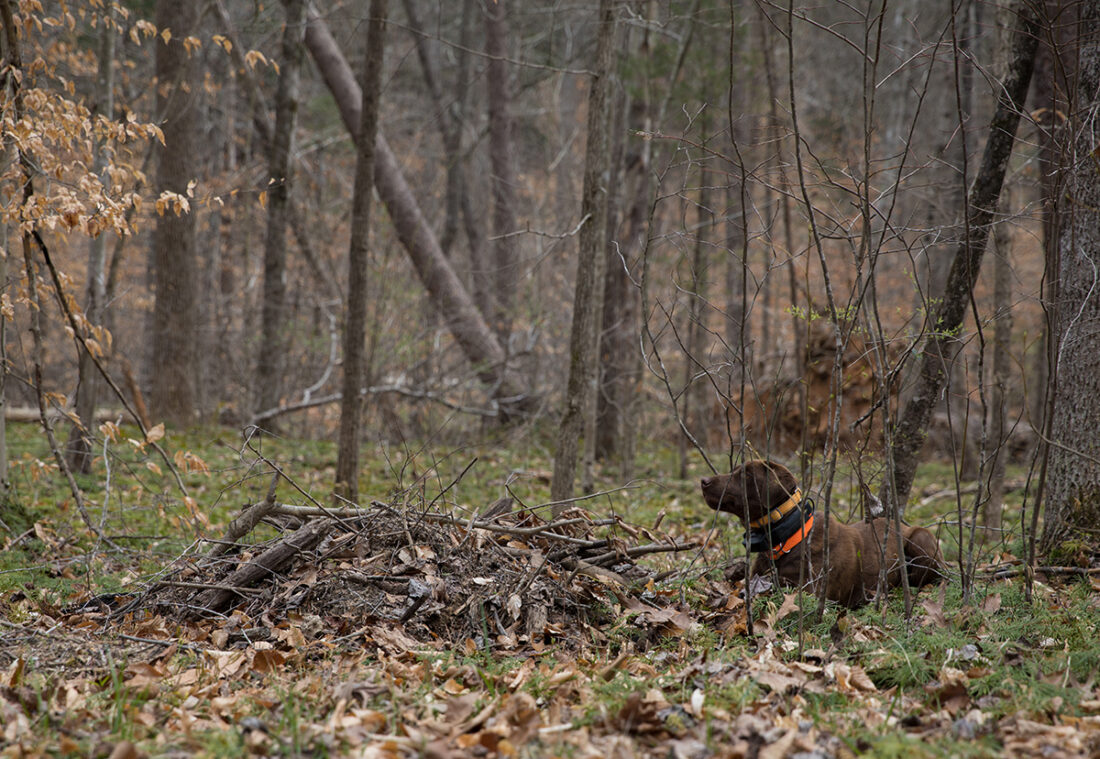
Reese alerting to her find.
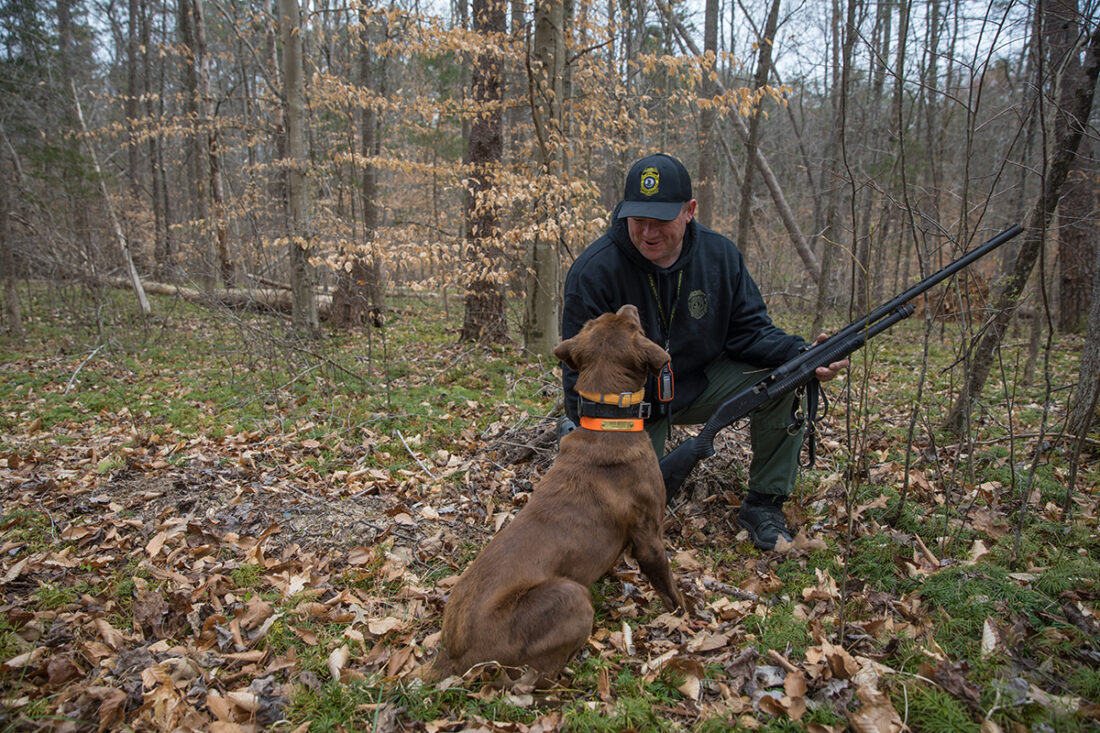
CPO Ian Ostlund congratulating Reese on her find.
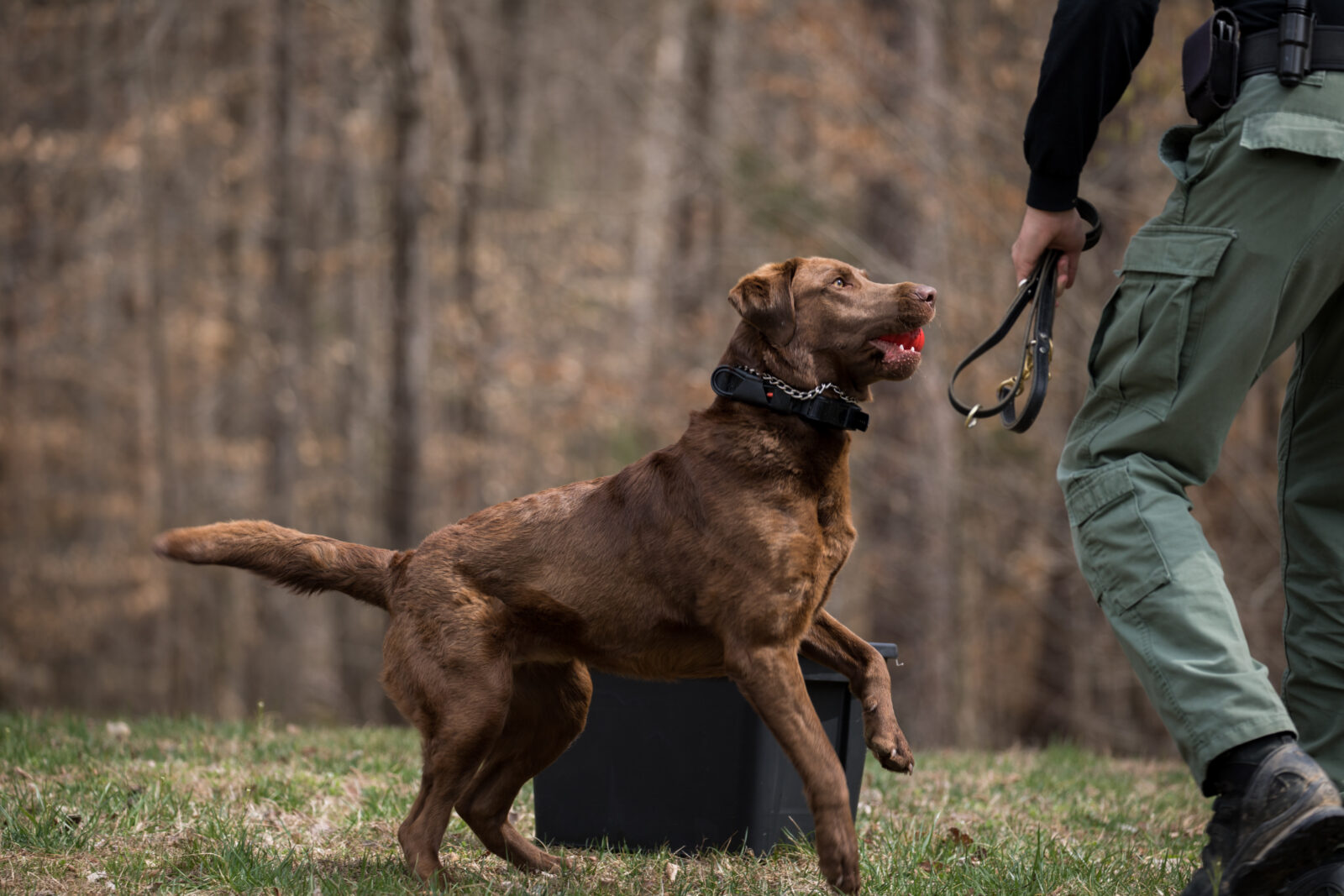
Bruno enjoys some play reward after a successful wildlife detection exercise.
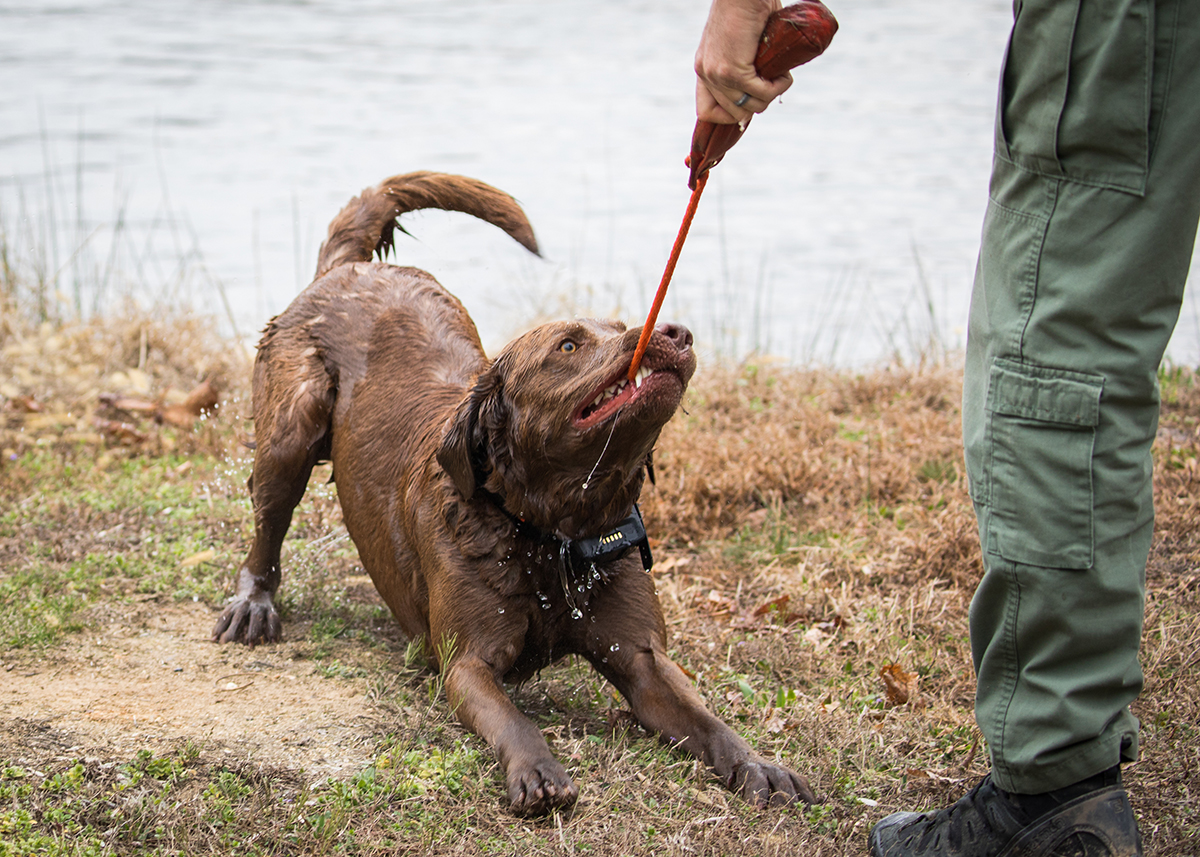
Keeping things fun for the dogs is a priority.
